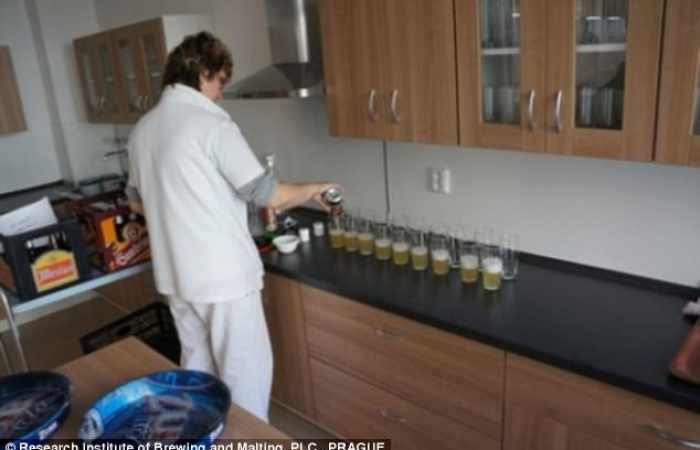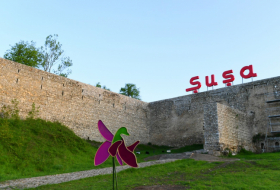They also tasted the beers and said they ranged from intensely sulfuric to sour, and had flavors that ranged from fecal to fruity.

The three lager beers apparently were produced during the World War I era and stored in a large cold cellar at the brewery, where they were gathering dust.
The beer, which was bottled in dark glass and well sealed, was discovered during the reconstruction of a brewery in Záhlinice, Czech Republic.
The researchers, based at the Research Institute for Brewing and Malting in Prague, Czech republic, decided to analyze the beer for insights into early 20th century brewing processes, as well as the chemical changes that occur in beer over long periods of time.
To analyze the beers, the researchers began by tasting it.
In their study, they wrote: 'Because of the small volume of the century-old beer samples, sensory analysis was carried out by only five members of our sensory panel.
'A descriptive analysis of flavor and taste was performed immediately after opening of the bottles'.
Following this, they conducted a chemical analysis to identify properties such as the original extract, alcohol content, color and total acidity.
They used a method called high performance liquid chromatography as well as other techniques to compare the beers' features to those of modern day brews.
The old beers had higher alcohol content and were less bitter than the beers of today.
They also contained more iron, copper, manganese and zinc.
The researchers also conducted a DNA analysis of the beer to identify any microorganisms present.
The first beer was 'sensorially the least acceptable,' according to the researchers.
'It was light, hazy with very intensive sulphuric and fecal off-flavor,' they wrote.
Although no yeast DNA was detected, the DNA of bacteria Staphylococcus and Streptomyces was found.
The second beer, the researchers said, resembled lambic - a beer brewed in the Pajottenland region of Belgium.
'It was dark, very sour with madeira and nicely fruity off-flavors,' they wrote.
No bacterial DNA was identified but several types of yeas were.
The third beer was light brown and contained traces of carbon dioxide bubbles.
'While the beer was oxidized, with typical sweetness and papery off-flavors, it was very slightly bitter and it really appeared as beer,' the researchers wrote.
This beer contained the DNA of yeast and bacteria and was the only one that tasted like beer of today.
The researchers said that the chemical changes in the first two beers were caused mainly by microbial contamination, whereas the third beer remained largely uncontaminated.
'The beer C (third beer) enabled us to acquire deeper knowledge about a 100-year-old beer which, due to undamaged sealing cork plug and most probably constant temperature in the cellar, underwent a “natural” aging process unmarred by microbial contamination, which resulted in an unspoiled sensory profile'.
The researchers concluded their study writing 'One can assume that a century ago our ancestors produced beer from similar raw materials and in a similar way as today'.
HISTORICAL BREW RECIPES
Midas Touch
Somewhere between beer, wine and mead, this drink is based on molecular evidence found in a Turkish tomb believed to have belonged to King Midas, dating back to 700 BC. It’s a sweet yet dry beer made with honey, barley malt, white muscat grapes and saffron.
Chateau Jiahu
This 9,000-year-old Chinese drink is made with hawthorn fruit, Chinese wild grapes, rice and honey. It is the oldest known fermented beverage in history.
Theobroma
Found in Honduras, Theobrama is brewed with artisanal dark chocolate from the ancient cacao area of Soconusco, honey, chilies, corn and annatto or achiote (fragrant and reddish, imitating sacrificial blood). It dates back 3,400 years, based on chemical analysis of pottery fragments found in Honduras which contained the earliest chocolate beverage from the Americas..
Ta Henket
The ingredients of this drink are based on chemical and botanical analyses of Egypt's oldest known wine (about 3150 BC) and other sites dating back 18,000 years, in addition to ancient Egyptian hieroglyphic inscriptions and artistic depictions of brewing. It uses an ancient species of wheat (einkorn) for hearth-baked bread, with added chamomile, doum palm fruit and Middle Eastern herbs.
Birra Etrusca Bronze
This 2,800-year-old drink uses two-row malted barley and an heirloom Italian wheat. It heralds from Italy and also contains speciality ingredients such as hazelnuts, pomegranates, Italian chestnut honey and wildflower and clover honeys from Delaware, and myrrh. The Dogfish version was brewed with bronze (replicating the ancient vessels made of this metal alloy); the Italian versions were brewed in replica Etruscan pottery jars and oak barrels.
Kvasir
Chemical, botanical and pollen evidence are the basis for this 'Nordic grog,' which is attested at sites in Sweden and Denmark from the Bronze Age to Roman times. The contents of a 3,500-year-old Danish drinking vessel exemplifies this drink. The vessel was made of birch bark and found in the tomb of a leather and woollen-clad woman, who was possibly a priestess. The ingredients are sourced from the far north: red winter wheat, lingonberries, cranberries, bog myrtle (Myrica gale), yarrow, honey, juniper, and birch syrup. Imported wine from southern and central Europe was also added to the bracing northern brew.
/Daily Mail/
















































